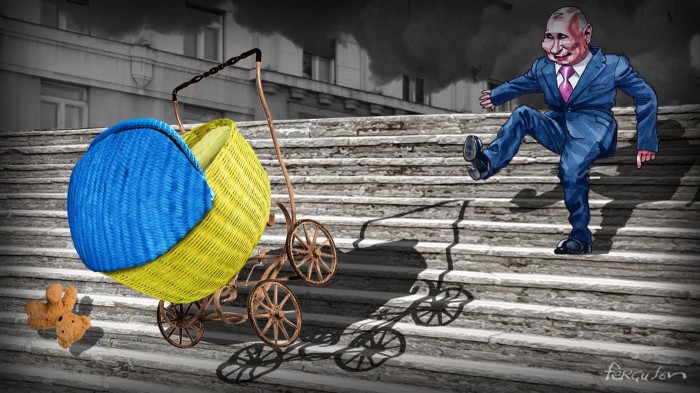Do not expect the war in Ukraine to end quickly


Simply sign up to the War in Ukraine myFT Digest -- delivered directly to your inbox.
“Tell me how this ends?” is one of those things that people say in films — and sometimes also in real life. It is the crucial question about the war in Ukraine — but one that is sometimes obscured by the sheer drama and horror of day-to-day events.
Just before the outbreak of the war, most military experts expected a swift Russian military victory. That turned out to be wrong — and there will be more surprises in store. So all predictions have to be made with humility.
That said, there are three Ukraine scenarios which currently seem most likely. The first — which is both the most tragic and the most probable — is that this war continues for many months. The second possibility — put it at maybe 30 per cent — is that there is a peace settlement. The third scenario — which is perhaps 10 per cent — is that there is some sort of political upheaval in Russia, involving the overthrow of President Vladimir Putin and a new approach to Ukraine.
The long, grinding war scenario assumes that neither Russia nor Ukraine is now capable of achieving total victory and that neither is prepared to concede defeat. Putin is fighting to save his political life and the Ukrainians are fighting to save their country.
After almost a month of conflict, Russia has failed to take control of any of Ukraine’s major cities and has suffered heavy losses of men and equipment. The Russians may be about to conquer the strategic port of Mariupol — but only by destroying it in the process.
The increasing brutality of Russian tactics, which is on full display in Mariupol, is a guide to the future. As they get more desperate, the Russians may become even more vicious. There are ominous indications that the Kremlin is considering the use of chemical weapons already used in Syria.
But Kyiv has roughly six times the population of Mariupol. Surrounding Ukraine’s capital, bombarding it into submission and then successfully taking control of it looks beyond the capabilities of the Russian military. Even capturing Odesa, which would allow Russia to effectively control Ukraine’s coastline, could take months and involve the destruction of the port city that serves as the headquarters of the Ukrainian naval forces.
As well as causing terrible casualties, a prolonged war would steadily increase the risk of escalation. The pressure on western leaders to intervene would increase as atrocities get worse. The US and European governments are likely to continue resisting that pressure. But stepped-up military assistance to Ukraine may blur the line between intervention and non-intervention — raising the risk of a direct clash between Russia and the west.
The appalling losses for both sides, now and in the future, should increase the prospects for a negotiated peace. The Russians and Ukrainians have been talking almost from the beginning of the conflict. The Ukrainians seem to have accepted that they will not join Nato and will instead be a neutral state. That was one of Russia’s major demands and might allow Putin to claim some sort of victory.
There are other big issues that remain unresolved. The status of Russian-occupied Crimea and of Donetsk and Luhansk, which Russia now recognises as independent states, is not agreed. A peace settlement might have to involve some kind of creative compromise that accepts the current status quo, without setting it in stone.
Even if these issues were agreed, other very difficult issues would remain. Ukraine — understandably — now wants some kind of international security guarantees.
But if that looked like Nato membership by another name, it might not be accepted by Russia or, indeed, by Nato governments themselves. Russia may demand the lifting of western sanctions as a condition to withdraw its troops. But the US and EU will be reluctant to end Russia’s pariah status, as long as Putin remains in power.
The current assumption in Washington is that the Russians are probably not negotiating in good faith. Even the announcement of a ceasefire is likely to be treated sceptically — since Russia may just use it as an opportunity to regroup militarily.
But if Putin is indeed still committed to war, he may be making another catastrophic error. The pressure on the Russian economy and military is only going to increase in the coming months. Some military analysts believe the army may soon run short of ammunition and troops. There are shortages in the shops and prices are rising.
Displays of public dissent continue in Russia, despite the risk to protesters. Putin himself has taken to issuing angry denunciations of traitors and fifth columnists. Some senior figures within the intelligence services have reportedly been put under house arrest.
On the other hand, translating all this confusion and panic into an effective palace coup against Putin is a very tall order. The Russian leader is very careful about his security — so careful that he does not seem willing to allow even close aides near him.
Dissenting voices were purged from the Kremlin a long time ago. There will be disagreement and distress throughout the Russian system — but co-ordinating that into an effective plot to remove Putin may not be possible.
So those are the three options: a prolonged war; a peace settlement; or a coup in Russia. Expect the first, work for the second and hope for the third.
Comments